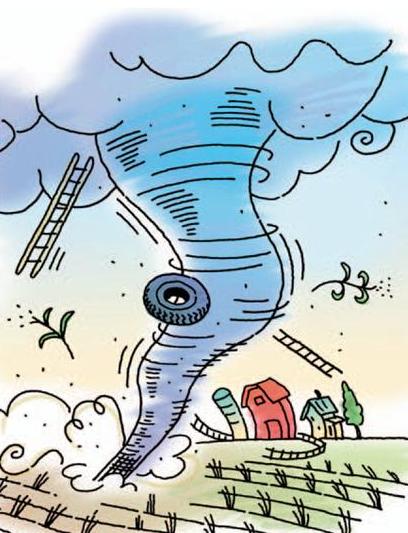The province of Ontario has some risk of experiencing a tornado. The risk is increased, however, in the Southwest, Southcentral, and Central portions of the province. Tornadoes, which spin off from powerful thunderstorms, can kill people and devastate neighborhoods in seconds. The rotating, funnel-shaped cloud can have whirling winds in excess of 500 kilometers per hour. Damage paths can be in excess of 2 kilometers wide and 80 kilometers long.
Before
.jpg) Stay informed—listen to a radio or the Weather Network to check local forecasts and news reports regularly. Keep a battery-powered or hand-cranked radio along with extra batteries.
Stay informed—listen to a radio or the Weather Network to check local forecasts and news reports regularly. Keep a battery-powered or hand-cranked radio along with extra batteries.
- Determine in advance where you will take shelter during a tornado. Basements and storm cellars are the best choices. If no underground shelter is available, choose an interior room or hallway on the lowest floor possible.
- Look for the following danger signs: dark, often greenish sky; large hail; a large, dark, low-lying cloud that may be rotating; and a loud roar similar to a freight train.
- If local authorities issue a tornado watch, remain alert for approaching storms, watch the sky, and stay tuned to the radio or television.
- If local authorities issue a tornado warning, take shelter immediately.
During
- If you are in a building, go to a pre-designated shelter area, such as a safe room, basement, storm cellar, or the lowest building level. If there is no basement, go to the center of an interior room on the lowest level. Stay away from corners, windows, doors, and outside walls. Put as many walls as possible between you and the outside. Get under a sturdy table and use your arms to protect your head and neck. Layers of clothes, even a mattress, can be pulled over your head to protect you from flying debris. Do not open windows.
 If you are in a vehicle, trailer, or mobile home, get out immediately and go to the lowest floor of a nearby, sturdy building or storm shelter. Mobile homes, even if tied down, offer little protection from tornadoes.
If you are in a vehicle, trailer, or mobile home, get out immediately and go to the lowest floor of a nearby, sturdy building or storm shelter. Mobile homes, even if tied down, offer little protection from tornadoes.
- If you are outside with no shelter, lie flat in a nearby ditch or depression and cover your head with your hands. Be aware of the potential for flooding. Do not get under an overpass or a bridge. You are safer in a low, flat location. Watch out for flying debris, which is the cause of most fatalities and injuries during tornadoes.
- Never try to outrun a tornado in an urban or congested area in a car or truck. Instead, leave the vehicle immediately for safer shelter.
After
- Stay out of damaged buildings.
- Stay clear of downed power lines.
- Help injured or trapped people.
- Check on others who may require assistance, such as the older adults, children, and people with disabilities.
Developed by NFPA. Funding provided by the U.S. Department of Homeland Security, Office of Domestic Preparedness.